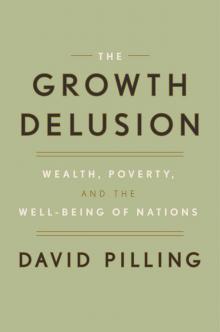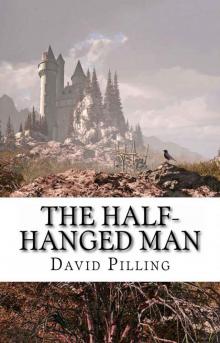- Home
- David Pilling
The Growth Delusion Page 6
The Growth Delusion Read online
Page 6
By tracking similar surveys back to 1965, researchers found that the amount of housework had actually dropped over the years. In 1965, it estimated, household production accounted for 39 percent of the economy, significantly more than today. It attributed the fall largely to changing lifestyles, as more women took paid jobs and as families ate out more, knitted fewer sweaters, and became less picky about cleaning up potato chips lurking under the sofa.
The UK’s Office for National Statistics has been conducting a similar exercise since 2002, when it published its first satellite account for household activity.20 It chose a different approach from the one adopted by American researchers. Instead of counting up hours of activity and applying a standard wage, it attempted to put a monetary value on household “output,” such as the number of meals prepared and children cared for. Studies have found that households can easily identify how often they use the washing machine, the type and quantity of meals prepared and so on. That still leaves the question of quality. A househusband might heat up a can of spaghetti hoops or prepare a cordon bleu dinner following a recipe. Unless you adjust for quality, these would both be counted exactly the same.
The paper divides household work into seven categories: shelter, including do-it-yourself maintenance; providing transport (all those car rides to ballet class); nutrition (those lukewarm spaghetti hoops); laundry services; childcare; care for elderly or disabled members of the household; and volunteer activities. As with traditional national income accounts, in each case intermediate consumption is removed. If a mother gives her child an apple that she has already paid for at the supermarket, it should not be counted again. If a father knits a sweater for his daughter then the cost of the wool must be deducted so that only the value-added of his labor counts and so on. Then a proxy price must be found. For example, the cost of taking the bus to school as opposed to getting a ride from your mother. At each stage one assumption is piled on another, from the amount and quality of the work done to the equivalent market price.
After making all these complex calculations for the year 2000, British statisticians found that total unpaid household work was worth £877 billion or about 45 percent of all economic activity for that year.21 Of that, £221 billion was attributed to the value of childcare, £164 billion to nutrition (perhaps more cordon bleu than spaghetti hoops after all), and £156 billion to transport. Laundry accounted for £46 billion. Voluntary activity came in at just £13 billion, which struck me as either an underestimate or an indication that the British are more interested in cleaning and pressing their shirts than helping out their neighbors. Similar exercises have been carried out in many countries, including Australia, Finland, Hungary, Germany, Mexico, and Nepal. Finland is typical in showing unpaid housework as contributing some 40 percent to total economic activity.22
One interesting finding of the 2012 American study was that counting home production lowers measured inequality. The reason is that poor people make their own beds just like rich people (unless the rich people have paid staff to do it for them). The imputed dollar value of a millionaire making his bed or ironing his shirt doesn’t vary much from a pauper performing the same task. Adding a small chunk of home production “income” to a poor family thus has a bigger effect, proportionately, than adding it to a rich one.23
The more we formally count housework as part of the economy, therefore, the more relatively equal our societies look. That is a counterintuitive result. Trying to count housework as part of economic activity would normally be considered a progressive idea, one designed to highlight the invisible work done disproportionately by women. Yet doing so would tend to de-emphasize the inequalities that are causing so much anger in many of our societies. Messing with economic statistics is never easy.
4
TOO MUCH OF A GOOD THING
The road from Reykjavik’s sleek airport to the Icelandic capital passes through a landscape of black lava, rocky scabs from previous molten eruptions that go on for mile after wide-open mile. A cold wind blows in from the Atlantic Ocean and the strewn rock is bathed in a brooding, beautiful light. The capital is sophistication itself. Home to roughly half of Iceland’s population of 334,000 people, its buildings resemble little ski chalets or competition-winners from architectural magazines. Icelanders are fashionably dressed. Prosperous, liberal and chic, Reykjavik is the kind of place where the cafés serve toasted date and kale sandwiches (open-face on dark brown bread, of course) and play warbling Ethiopian jazz.1
Still, eight years after the financial crisis, the scars of one of the most dramatic banking collapses in modern times are as visible as the rocks scattered by the volcanic eruptions. Six months before I arrived in October 2016, Sigmundur David Gunnlaugsson, the prime minister, had resigned after revelations that he and his wife had owned an offshore investment trust with multimillion-dollar claims on Iceland’s failed banks. The scandal, the latest in a cavalcade of post-crash revelations, had helped give life to the Pirate Party, an anarchist-leaning group with roots in online activism which was now threatening to upend the island’s cozy politics. The party was Iceland’s version of the radical movements—from both left and right—that had sprung up across Europe in the aftermath of the 2008 financial meltdown. Its logo was a black pirate flag.
Elections triggered by Gunnlaugsson’s resignation were just a few days away. Twelve parties were jostling for control of Iceland’s ancient parliament, founded in AD 930. There was a palpable sense of anger over what people saw as betrayal by the country’s elites.
At sixty-two, Sigmunder Knutsson, a man who wore his scowl on his sleeve, described himself as a poet and an economist. Many Icelanders think of themselves as having twin vocations, and not a few, including Birgitta Jonsdottir, the leader of the Pirate Party, consider themselves poets. These days fewer admit to being economists.
“When I think about politics in Iceland, it makes me want to vomit,” Knutsson told a reporter from the New York Times, tucking into a plate of fermented shark, a local treat, in a small café with worn tables and bare walls. “It’s all about corruption among a very small elite,” he said. “There is something that is not right. Something smells bad.”2
Arnan, a thirty-two-year-old former banker with shoulder-length blond hair, stopped in the street in front of the Hallgrimskirkja, a modern cathedral that looks like an about-to-blast-off space rocket, to voice much the same opinion. Iceland had traditionally been a farming country with an economy dominated by the big landowning families, he said. Those same families had used their wealth and influence to secure a monopoly over the island’s rich fishing quotas. In the latest iteration, he said, the self-same elite had taken over a banking sector that had expanded exponentially in the first years of this century.
The story of Iceland’s banking industry illustrates one of the messages of this book. Not all economic growth is good. Rapid growth comes in many flavors, and some of them are less appetizing than others. In the 1990s David Oddsson, Iceland’s longest-serving prime minister, oversaw a Thatcherite orgy of deregulation that transformed Iceland from sleepy fishing nation to pioneer of turbocharged “Viking capitalism.”3 After the banks were privatized in 2002, three institutions, Glitnir, Kaupthing and Landsbanki, went on an incredible expansion binge fueled by cheap borrowing from other cash-flush banks. They lent money to friends and to each other and set off on a madcap spending spree, picking up assets all across Europe, from English football teams to Danish airlines. Stefan Olafsson, an Icelandic professor, called it “probably the most rapid expansion of a banking system in the history of mankind.”
Iceland changed from a country into what one writer called a giant hedge fund.4 Its gung-ho young business titans swallowed whole the economic philosophy they had learned at American business schools. Together with normally sober Icelandic citizens they participated in a bout of collective madness. It wasn’t long before most Icelanders discovered the trick of borrowing cheaply i
n foreign currencies abroad and pumping the money into the local stock market, which increased in value nine times between 2003 and 2007. They invested in local property, whose value also went up and up and up, confirming their secret suspicion that they were investment geniuses. Consumption went wild. It became fashionable to hire helicopters to pop over to the other side of the island for picnics. One particularly exuberant Icelander paid $1 million to hear Elton John sing two songs for his birthday. By my reckoning, that’s $500,000 a song.5
What ordinarily sober citizens did, the banks did on steroids. The business of banking is credit creation, and Iceland’s institutions took their job seriously. At the peak of the insanity, the three main banks’ assets were worth 14.4 trillion krona, or an astonishing ten times Iceland’s national income. Not everything that was being done was, shall we say, legal. Michael Lewis, a financial author, quotes one hedge fund manager as describing some of the transactions between Iceland’s banks. “You have a dog, and I have a cat. We agree that each is worth a billion dollars. You sell me the dog for a billion, and I sell you the cat for a billion. Now we are no longer pet owners, but Icelandic banks with a billion dollars in new assets.”6
As banks’ activity expanded, so did their apparent contribution to the economy. While the fishing industry’s share of output dropped from 16 percent of GDP in 1980 to 6 percent in 2006, the share of finance, insurance, and real estate went rapidly in the other direction. In the eight years to 2006, it rose from 17 percent of economic output to 26 percent.7 From the perspective of national accounting, bank expansion was a wonderful thing. It brought growth and yet more growth. Indeed, per-capita income exploded, reaching around $45,000 a head in 2006, making Iceland the sixth-richest country on earth. Kaupthing, the largest privatized bank, went on a binge of buying, merging and deal-making. It opened up an Internet bank, Kaupthing Edge, with branches in ten European countries, in a valiant effort to hoover up retail savings. Iceland had almost no track record in global finance, yet within a few years, according to one banker, Kaupthing began to think of itself as “the Goldman Sachs of the Arctic.”8
Then—and you probably guessed this was coming—it all went horribly wrong. And I mean horribly. When Lehman Brothers went bust in September 2008, trust in the entire global financial system vanished overnight. Banks stopped lending to each other, unsure whether their counterparties were good for the money or whether their balance sheets too were riddled with toxic assets. For Icelandic banks, leveraged up to the hilt, it was the end of the road.
Within ten days, Glitnir, the third largest, asked for a government bailout. As the krona plummeted and news spread that the financial system was insolvent, Icelanders started removing cash from banks by the bag-load. Many were left with huge debts in foreign currency which they had to repay with a sinking krona. Within a few weeks all the banks had been nationalized. In Britain, where 300,000 people and some local councils had put money in Icelandic banks, Gordon Brown, the prime minister, invoked anti-terrorism laws to try to recoup lost savings. Geir Haarde, Iceland’s prime minister at the time, was not exactly sugarcoating his words when he said, “The danger is real that the Icelandic economy would be sucked, along with banks, under the waves and the nation would become bankrupt.”9
By the end of October, Iceland, just months previously an apparently roaring success, had gone cap in hand to the International Monetary Fund for a bailout. The stock market fell 85 percent and every Icelandic man, woman, and child was on the hook for their $330,000 share of the $100 billion in losses racked up by reckless banks.
* * *
—
I strolled over to the annex of Iceland’s parliament, a modestly proportioned building that resembles a modern art gallery, to see Birgir Armannsson. A neatly dressed man in a soft gray suit, Armannsson is a senior member of the center-right Independence Party, which was part of the ruling coalition when Iceland was leaping, lemming-like, off the financial cliff. As a young lawyer in the 1990s, he had noticed attitudes to finance change. “Icelandic business people became richer than ever before and started to lose all connection with the Icelandic people, with the Icelandic community,” he said. In the following decade it got worse. “They became international billionaires instead of being rather well-off local business people. They started to buy private jets and yachts, something we had never before seen in Iceland. Before, it was good, maybe, to have two cars.”
Armannsson watched the process unfold at close hand. “Icelandic banks got cheap loans all over the world and they were pumping money into local companies. The stock market rose dramatically and nobody thought it would ever go into reverse.” Were there no warning signs? I asked. Didn’t the sudden rise in living standards and the massive paper gains look too good to be true? “Well into 2008, the outlook looked good. That was what parliamentarians thought, including myself. In retrospect we should have been quicker to respond to the rising problems,” he said. “It has also come to light since the crisis that Icelandic bankers were manipulating the market and were deeply involved in insider trading. A lot of it was just a bubble.”
I asked whether he thought conventional accounting had overstated the contribution of banks to the economy. “It would take someone with more expertise than me,” he said. “This is a complicated issue.” Then he added, as if it might be of some comfort, “I think we have limited possibility of the same crisis. Probably the next financial crisis will be a little bit different.”
* * *
—
Just to be absolutely clear: the 2008 banking crisis, whose effects were still rippling through the world nearly a decade later, cannot be blamed on the way we account for financial services in our national accounts. The crisis had its roots in race-to-the-bottom deregulation, naive faith in the capacity of markets to self-correct, and a perverse “shareholder-value” ideology that allowed a few thousand masters-of-the-universe bankers to ransack their own institutions while simultaneously feeling good about themselves. There were many other factors, from the hugely increased (and unnecessary) mathematical complexity of financial instruments to the inherently corrupt relationship between the ratings agencies and the clients who paid them. The rampant fad of securitization was another ticking time bomb. This was the practice of dicing and slicing different revenue streams and smushing them together into a tradable asset, a practice that severed the traditional link between lender and borrower. After a while people were happily trading bits of paper—all triple-A rated, naturally—blissfully unaware of what the underlying assets actually contained. As we now know, much of it was mortgage debt taken out on homes by people who could not afford to make their payments.
Yet the banking crisis was linked to national accounting in two important ways. The first is as much psychological as anything else. This is what you might call the danger of the circular argument, one that goes like this: “We all know growth is good. Growth is measured by GDP. So when GDP is going up that must be good. Giving free rein to banks to do their thing is a recipe for higher GDP. Ergo giving free rein to banks must be good.”
That led ambitious governments around the world, including Iceland’s, to ape the Anglo-Saxon model, one that involved liberalization, deregulation, and privatization. Really anything with a “tion” on the end of it would do. Banks were allowed to get on with the business of “wealth creation”—which mostly meant shuffling bits of paper among themselves, lending recklessly, and paying themselves fat bonuses. The global cheerleaders for these policies were the US and the UK, where Ronald Reagan and Margaret Thatcher had set the deregulation agenda in motion and where Wall Street and the City of London were rampant. Not only was it obvious how much money bankers were making—you only had to look at the cars they were driving to see that—but they also spent formidable amounts of money lobbying governments to make life yet easier for them.
Banking became a bigger and bigger part of the US and UK economies. The “contribu
tion” of the financial sector to national income grew enormously. In the 1950s, when banks were banks rather than “great vampire squids,” they contributed about 2 percent to the US economy.10 By 2008, that had quadrupled.11 Similar things happened in Britain. Until 1978 financial intermediation accounted for around 1.5 percent of whole economy profits. By 2008, that ratio had risen to about 15 percent.
The perceived success of financial deregulation in generating economic dynamism encouraged other countries to do the same. New Zealand, Australia, Ireland, Spain, Russia, and even little Iceland were seduced by the Anglo-Saxon model. The financial industry exploded all over the world. For the year to April 2008, the largest 1,000 banks reported aggregate pre-tax profits of almost $800 billion.12 Countries that adopted these policies, including ones that gave freer and freer rein to their “wealth-creating” banks, did well, while others appeared to lag. The way we think of economic growth tends to tell you one thing: the bigger the banks grow the better.
As the idea that an unbridled banking industry led to a strong economy took hold, governments did all they could to foster the growth of the financial sector. For the most part, that meant getting out of the way. From the mid-1980s, states rolled back banking industry regulations, many of them put in place after the 1929 Wall Street crash. In America the separation of investment from commercial banking was steadily eroded until it was abandoned altogether with the repeal of the Glass-Steagall Act in 1999. In the mid-1980s London had its Big Bang, which swept away regulations and paved the way for huge financial conglomerates. As in Iceland, banks that had once relied on steady retail depositors for their capital took to the wholesale markets, sucking up and recycling first petro-dollars from the Middle East and then the surplus savings of workers and peasants in booming China.13

 The Growth Delusion
The Growth Delusion The Hooded Men
The Hooded Men Longsword
Longsword Medraut
Medraut Hardway
Hardway Holy Warrior
Holy Warrior Caesar's Sword: The Complete Campaigns
Caesar's Sword: The Complete Campaigns The Wolf Cub
The Wolf Cub Reiver
Reiver The Heretic
The Heretic Siege of Rome
Siege of Rome Loyalty
Loyalty The Path of Sorrow
The Path of Sorrow Caesar's Sword (I): The Red Death
Caesar's Sword (I): The Red Death Flame of the West
Flame of the West The Best Weapon
The Best Weapon Sacrifice
Sacrifice The Half-Hanged Man
The Half-Hanged Man